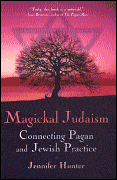
This is a delicious book that every neopagan who’s rebelled against his or her childhood Christian church needs to be reading. Most of us leave home (so to speak) and start reading books for guidance along our new path. Most of these books focus on Greco-Roman-Egyptian pantheons and prescribe the Celtic calendar. No matter where we live, we are taught to believe that these ancestors are Our True Pagan Ancestors, spiritually, if not genetically. Then we add some massive New Ageish borrowing from Native American spirituality to the cauldron of our reading, plus our Western semi-understanding of Hinduism and Buddhism, and we think the stew we thus cook up is what neopaganism really is. It’s not necessarily so. There’s lots more. Jean Markale, for example, has written widely on the beliefs and practices of the pre-Christian Continental Celts, and the Heathens have galloped off to worship the Norse and Germanic pantheons.
And that leaves the Jewitches. If we grew up in a Christian household, what we know about Judaism probably comes from a combination of semi-remembered Sunday school stories, Fiddler on the Roof, and The Ten Commandments. Perhaps we think the Abrahamic religions invented monotheism and killed the Goddess. Perhaps we’ve hopped on the Kabbalah bandwagon, but what do we really know about it? It didn’t come from outer space or prehistory; some celebrities who have adopted Kabbalism don’t seem to be aware of its Jewish roots. Or perhaps we equate the religion with Zionism. What connection can there be between Judaism and neopaganism?
Drawing on the experience and idiosyncratic wisdom of thirteen interviewees (including a ceremonial magician, a rabbi, and Starhawk and Marion Weinstein), Jennifer Hunter reveals the magical roots and branches of Jewish religious practice. Starting with a review of history, she shows how “new paths are built up on top of the old; tribes living side by side cross-pollinate their deities” (p. 23). Contrary to what the Bible would have us believe, the Jews were not chosen and separate. The Bronze Age and Iron Age Hebrews and Canaanites were neighbors. “The religious vocabulary of the Hebrew Bible,” says interviewee Steve Posch, “is entirely Canaanite. All these ancient cultures that are going on in this area, the Hebrews, the Ammonites, the Moabites, and the Phoenicians—we think of them as being separate cultures and separate languages…but in fact they’re not. They’re all regional variations of the same culture” (p. 24). As the archaeological record shows, the “everyday folks” in the Hebrew tribes were worshiping the Canaanite pantheon. El, the gray-bearded king of the gods, is the “blueprint” for YHVH. He is the all-wise creator of the universe and founder of laws and rituals, and he’s also vigorous and lusty. Asherah, Lady of the Sea, is his wife and partner; associated with her are numerous animals, and her icon is the tree. Until the Captivity, there were Asherahs in the Temple. Anath, the lusty virgin warrior, is their daughter, and their son, the horned god Ba’al, may be the original of Gerald Gardner’s horned god.
Chapters in Magickal Judaism cover history and mythology (and this chapter is a major eye-opener); Kabbalah and mystical Judaism; “Wrestling with God(s)”—thorny topics here, like politics, divine gender, polytheism and monotheism, what idolatry really means; the Circle of the Year and the similarities in the Jewish and neopagan calendars; Magick and Ritual, another chapter full of revelations; Shabbat and Daily Practice; and Community and the Future, in which Hunter asks
What can NeoPaganism and Judaism give to each other? Many folks I interviewed said that Judaism could give NeoPaganism ethics and a sense of history and culture. NeoPaganism could give Judaism a sense of fun, a focus on nature, and a sense of pluralism—not to mention helping Judaism’s magickal roots remerge [sic.] (p. 223).
The book concludes with a glossary, notes, bibliography, recommended web sites, and an index. All along, Hunter tells us how to pronounce Hebrew words. Also included are some wonderful small rituals, like the General Invocation of the Deities created by Lilinah Biti-Anat, another interviewee:
We call on the Gods and Goddesses who reign in the heavens
Let honor be paid to those that are on high who nurture and bless us;
and to those who in the sand-swept tracts of wilderness protect and watch over us;
and to the other celestial, terrestrial and chthonic Deities who guide us, teach us,
bring us through difficult times, and fill our hearts with joy in their presence.
Let a crown be placed on their heads and set a diadem upon their brows!
Ho, Eat of bread, and drink of foaming wine, hey!
Welcome, O King! Welcome, O Queen!
Welcome, kohanot, kohanin, and celebrants (p. 43)!
~review by Barbara Ardinger, Ph.D.
Author: Jennifer Hunter
Citadel Press, 2006
pp. 270, $12.95
